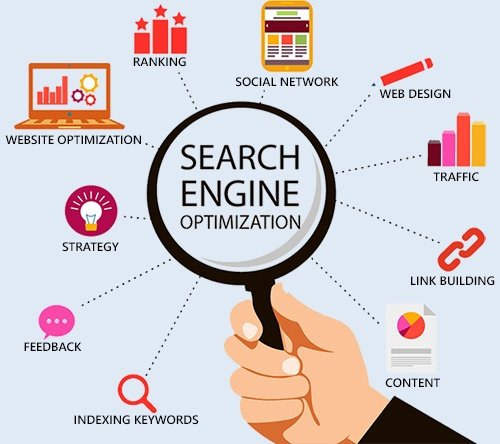SEO Step-by-Step Tutorial: 8 Easy Basics for Beginners to Master
Before delving into the specifics, it’s essential to understand what SEO is and why it matters. SEO is the process of optimizing your website to improve its visibility and ranking on search engine results pages (SERPs).
When users search for relevant keywords, SEO helps your website appear higher on the search results, driving more organic traffic.
Understanding Search Engines
To excel in SEO, you must understand how search engines work. Search engines like Google use complex algorithms to analyze websites and determine their ranking.
These algorithms consider various factors such as keywords, content quality, user experience, and backlinks. By understanding these mechanisms, you can tailor your SEO efforts accordingly.
Keyword Research and Analysis
Keywords are the foundation of SEO. Effective keyword research involves identifying the phrases and terms users are likely to search for. Tools like Google’s Keyword Planner can help you discover relevant keywords with search volume and competition data.
Additionally, analyzing your competitors’ keywords can provide valuable insights.
– Utilizing Long-tail Keywords
Long-tail keywords are specific and more extended keyword phrases that target a niche audience. They have lower search volume but are highly relevant. Integrating long-tail keywords into your content can boost your chances of ranking higher for specific searches.
– Competitor Analysis
Analyzing your competitors’ SEO strategies can give you a competitive edge. Identify their top-performing keywords, backlinks, and content strategies to refine your approach.
On-Page SEO
On-page SEO involves optimizing elements on your website to enhance its search engine visibility.
– Crafting Engaging Titles and Meta Descriptions
Captivating titles and meta descriptions entice users to click on your links. They should be informative, compelling, and include relevant keywords.
– Optimizing Headers and Subheadings
Proper use of H1, H2, H3, and H4 tags improves content structure and makes it more accessible to search engines and readers.
– Creating High-Quality Content
High-quality, valuable content is the backbone of successful SEO. Focus on relevance, readability, and addressing user intent.
– Implementing Keyword Placement
Strategically place keywords throughout your content, including in the title, headings, and body. However, avoid keyword stuffing, as it can lead to penalties.
– Utilizing Internal Links
Internal linking helps search engines discover and index other pages on your site. It also improves user navigation and engagement.
– Image Optimization
Optimize images by using descriptive alt text and reducing file sizes to enhance page load speed.
– Improving Website Speed
A fast-loading website enhances user experience and positively impacts SEO. Regularly optimize and compress images, use caching, and choose reliable hosting.
Off-Page SEO
Off-page SEO involves activities outside your website that influence its ranking.
– Link Building Strategies
Acquire high-quality backlinks from authoritative websites to establish credibility and boost your rankings.
– Guest Blogging
Writing guest posts for other relevant websites allows you to reach a broader audience and gain backlinks.
– Social Media Presence
Engage with your audience on social media platforms to build a loyal following and drive traffic to your website.
– Online Directories and Citations
Listing your business on online directories and obtaining citations helps improve local SEO and visibility.
Technical SEO
Technical SEO focuses on the technical aspects that affect search engine visibility.
– Website Structure and Navigation
Ensure your website has a clear and user-friendly structure, allowing search engines to crawl and index it efficiently.
– Mobile Optimization
Given the prominence of mobile users, optimizing your website for mobile devices is vital for SEO success.
– URL Structure
Use descriptive and concise URLs that include relevant keywords and reflect your content.
– HTTPS and Security
Secure your website with HTTPS to gain user trust and improve SEO rankings.
– XML Sitemap
An XML sitemap helps search engines understand your site’s structure and index it appropriately.
– Robots.txt
The robots.txt file instructs search engines on which pages to crawl and which to exclude, ensuring efficient indexing.
Monitoring and Analytics
Monitoring your SEO efforts is crucial to track progress and make data-driven decisions.
– Setting Up Google Analytics
Integrate Google Analytics to gain insights into your website’s traffic, user behavior, and more.
– Understanding Key Metrics
Key metrics like bounce rate, organic traffic, and conversion rates help gauge the effectiveness of your SEO strategies.
– Tracking SEO Progress
Regularly analyze and evaluate the impact of your SEO efforts to identify areas for improvement.
Local SEO
For businesses with a physical presence, local SEO is essential for attracting local customers.
– Google My Business
Claim and optimize your Google My Business listing to appear in local search results and Google Maps.
– Local Keyword Targeting
Incorporate location-specific keywords to target local customers effectively.
– Customer Reviews and Testimonials
Encourage customers to leave reviews and testimonials, as positive feedback can boost local search rankings.
Voice Search Optimization
With the rise of voice-enabled devices, optimizing for voice search is becoming increasingly important.
– Understanding Voice Search
Voice search queries are often more conversational. Understand user intent to tailor your content accordingly.
– Optimizing for Voice Queries
Create content that directly answers common voice search queries in a natural and conversational tone.
Content Marketing and SEO
Content marketing and SEO go hand in hand to attract and engage your target audience.
– Creating Engaging Content
Produce high-quality, valuable content that addresses your audience’s pain points and interests.
– Promoting Content
Use various channels like social media, email marketing, and influencer outreach to promote your content and gain backlinks.
Common SEO Mistakes to Avoid
Steer clear of these common SEO mistakes that can harm your website’s ranking and reputation.
– Keyword Stuffing
Excessive use of keywords within your content can lead to unnatural-sounding sentences and a poor user experience.
– Ignoring Mobile Users
Failing to optimize for mobile devices can result in a high bounce rate and lower search rankings.
– Neglecting Local SEO
For businesses with a local presence, ignoring local SEO practices can hinder visibility within the target market.
– Poor Website Structure
A disorganized website structure can confuse both users and search engines, impacting your rankings.
– Black Hat SEO Techniques
Engaging in unethical SEO practices, such as buying links or keyword stuffing, can lead to penalties and a significant drop in rankings.
The Future of SEO
Stay ahead of the game by understanding the future trends and advancements in SEO.
– AI and SEO
Artificial intelligence is increasingly shaping the way search engines rank websites and deliver search results.
– Voice Search Trends
The growing popularity of voice search will influence how users interact with search engines.
– User Experience
User experience will continue to be a critical factor in determining search rankings.
Conclusion
SEO might seem intimidating, but mastering the basics is essential for online success. By understanding search engine algorithms, conducting thorough keyword research, and implementing on-page, off-page, and technical SEO strategies, you can improve your website’s visibility and attract more organic traffic. Remember to stay up-to-date with the latest SEO trends and continually monitor your progress through analytics. With dedication and consistent efforts, you’ll see your website climb the search engine rankings and achieve long-term success.









